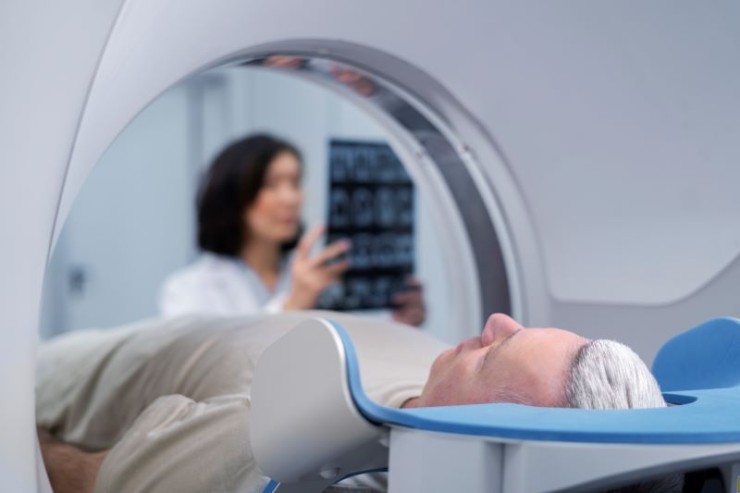
The PET-CT Whole Body Scan represents a technological synergy, fusing metabolic and anatomical imaging modalities.
PET-CT Whole Body Scan in India with Cost
PET-CT Whole Body Scan
in Detail: Unveiling a Comprehensive Diagnostic Approach
In the realm of advanced medical imaging, the PET-CT Whole Body Scan emerges as a powerful diagnostic tool, combining the strengths of Positron Emission Tomography (PET) and Computed Tomography (CT) to provide a holistic view of the body's internal structures and metabolic activity. This comprehensive guide aims to elucidate the significance, procedure, and applications of the PET-CT Whole Body Scan, offering a detailed understanding of its role in modern healthcare.
Introduction
The PET-CT Whole Body Scan represents a technological synergy, fusing metabolic and anatomical imaging modalities. This dual-imaging approach enables healthcare professionals to assess not only the structural details of organs and tissues but also their metabolic activity, contributing to a more thorough diagnosis and treatment planning.
Understanding PET-CT Imaging
Positron Emission Tomography (PET):
Within the PET segment, a minute quantity of a radioactive tracer, commonly fluorodeoxyglucose (FDG), is administered into the body. This tracer gathers in regions exhibiting elevated metabolic activity, such as cancer cells, and releases positrons.
Computed Tomography (CT):
The CT component utilizes X-rays to create detailed cross-sectional images of the body's anatomy, capturing structural details with high resolution.
Fusion of PET and CT Images:
The PET and CT images are then meticulously fused, generating a comprehensive visual representation that correlates metabolic activity with precise anatomical localization.
Importance in Diagnostic
Imaging
The PET-CT Whole Body Scan holds paramount importance in various medical scenarios:
Cancer Staging and Detection: Essential for
identifying and characterizing tumors by assessing both metabolic activity and
anatomical details.
Treatment Response Evaluation: Enables
healthcare providers to gauge the effectiveness of cancer treatments based on
changes in metabolic activity.
Cardiovascular Assessments: Useful in
evaluating blood flow, identifying coronary artery disease, and assessing
cardiac function.
Neurological Disorders: Aids in the
diagnosis and evaluation of conditions such as Alzheimer's disease and epilepsy.
Preparation for PET-CT
Whole Body Scan
Preparation for a PET-CT Whole Body Scan typically involves:
Fasting: Patients are often required to
fast for a specific duration before the scan to enhance tracer uptake.
Hydration: Staying well-hydrated before and
after the scan is recommended.
Medication Adjustments: Temporary
cessation or adjustment of certain medications may be necessary.
Procedure: Unveiling the
Body's Complexity
Tracer Administration: The patient receives
the radioactive tracer intravenously, which begins to accumulate in areas with
high metabolic activity.
Uptake Period: The tracer is allowed to circulate
and accumulate in the body, providing insights into metabolic processes.
Imaging Process: The combined PET and CT scanner
captures images, producing a fused representation that overlays metabolic and
anatomical details.
Assessment Areas in
PET-CT Whole Body Scan
PET-CT Whole Body Scans are employed to assess various aspects of health, including:
Cancer Detection and Staging: Identifying the
presence, location, and extent of tumors.
Cardiovascular Evaluation: Assessing blood
flow, coronary artery disease, and cardiac function.
Neurological Imaging: Diagnosing and
evaluating conditions affecting the brain and nervous system.
Benefits of PET-CT Whole
Body Scan
Comprehensive Assessment: Provides a detailed and
comprehensive evaluation of both metabolic and anatomical aspects.
Precise Cancer Staging: Essential for
accurate cancer staging and treatment planning.
Treatment Response Monitoring: Allows
healthcare providers to monitor the effectiveness of cancer treatments.
Risks and Considerations
The PET-CT Whole Body Scan involves exposure to low levels of radiation. However, the benefits of comprehensive diagnostic information generally outweigh the associated risks.
Clinical Applications
PET-CT Whole Body Scans find applications in various clinical scenarios, including:
Oncology: Crucial for cancer diagnosis,
staging, and treatment evaluation.
Cardiology: Assessing cardiovascular health
and identifying coronary artery disease.
Neurology: Diagnosing and monitoring
neurological conditions.
Expert Perspectives
Radiologists, oncologists, cardiologists, and neurologists collaborate to interpret PET-CT Whole Body Scan results, providing expert insights into various medical conditions.
Technological Advancements
Continual advancements in imaging technology contribute to the refinement of PET-CT scanners, enhancing image resolution and diagnostic accuracy.
Patient Experience
While the PET-CT Whole Body Scan involves exposure to radiation, it is generally well-tolerated by patients. The procedure provides valuable information to healthcare providers without invasive measures.
Conclusion
In conclusion, the PET-CT Whole Body Scan represents a pinnacle in diagnostic imaging, offering a synergistic approach to understanding the complexities of the human body. Its applications in cancer diagnosis, treatment evaluation, and assessments of cardiovascular and neurological health contribute to advanced and comprehensive healthcare.
FAQs about PET-CT Whole Body Scans
Q: How long does a PET-CT Whole Body Scan typically take?
A: The duration of a PET-CT Whole Body Scan varies, but it usually takes around 30 minutes to an hour, including both the tracer uptake period and the imaging process.
Q: Are there any specific preparations required before undergoing a PET-CT Whole Body Scan?
A: Certainly, preparations may include abstaining from eating for a designated period, ensuring proper hydration, and potentially adjusting or temporarily halting specific medications. Your healthcare provider will furnish detailed instructions.
Q: Is the radiation exposure during a PET-CT Whole Body Scan harmful?
A: The amount of radiation used is generally considered safe. The benefits of obtaining comprehensive diagnostic information outweigh the associated minimal risks.
Q: Can I eat or drink before a PET-CT Whole Body Scan?
A: Fasting before the scan is often recommended to enhance the uptake of the radioactive tracer. However, your healthcare provider will provide specific instructions based on your individual case.
Q: Are there any age restrictions for undergoing a PET-CT Whole Body Scan?
A: There is no specific age restriction for a PET-CT Whole Body Scan. The appropriateness of the scan is determined based on the patient's health condition and the information needed for diagnosis.
Q: How often can a person undergo a PET-CT Whole Body Scan?
A: The frequency of PET-CT Whole Body Scans is determined by the healthcare provider based on the medical necessity of the procedure. It is not typically performed routinely but as needed for diagnosis and treatment monitoring.
Q: Can pregnant or breastfeeding individuals undergo a PET-CT Whole Body Scan?
A: Pregnant or breastfeeding individuals are generally advised to avoid PET-CT scans due to the potential risk to the developing fetus or the baby. Alternative imaging methods may be considered in such cases.
Q: Will I experience any side effects during or after the PET-CT Whole Body Scan?
A: The process is typically well-received, and adverse effects are uncommon. Some individuals might encounter slight discomfort from the injection, and there could be temporary exposure to radiation. Your healthcare provider will communicate and discuss any potential side effects with you.
Q: How soon will I receive the results of my PET-CT Whole Body Scan?
A: The time it takes to receive results may vary. The images need to be carefully analyzed by a radiologist, and the results will be communicated to you by your referring healthcare provider.
Q: Can a PET-CT Whole Body Scan detect all types of cancer?
A: PET-CT Whole Body Scans are highly sensitive in detecting various types of cancers, especially those with increased metabolic activity. However, the effectiveness depends on the type and characteristics of the cancer.
These FAQs provide additional insights into the PET-CT Whole Body Scan process, addressing common questions individuals may have before undergoing this advanced diagnostic imaging procedure.
(0)
Login to continue



